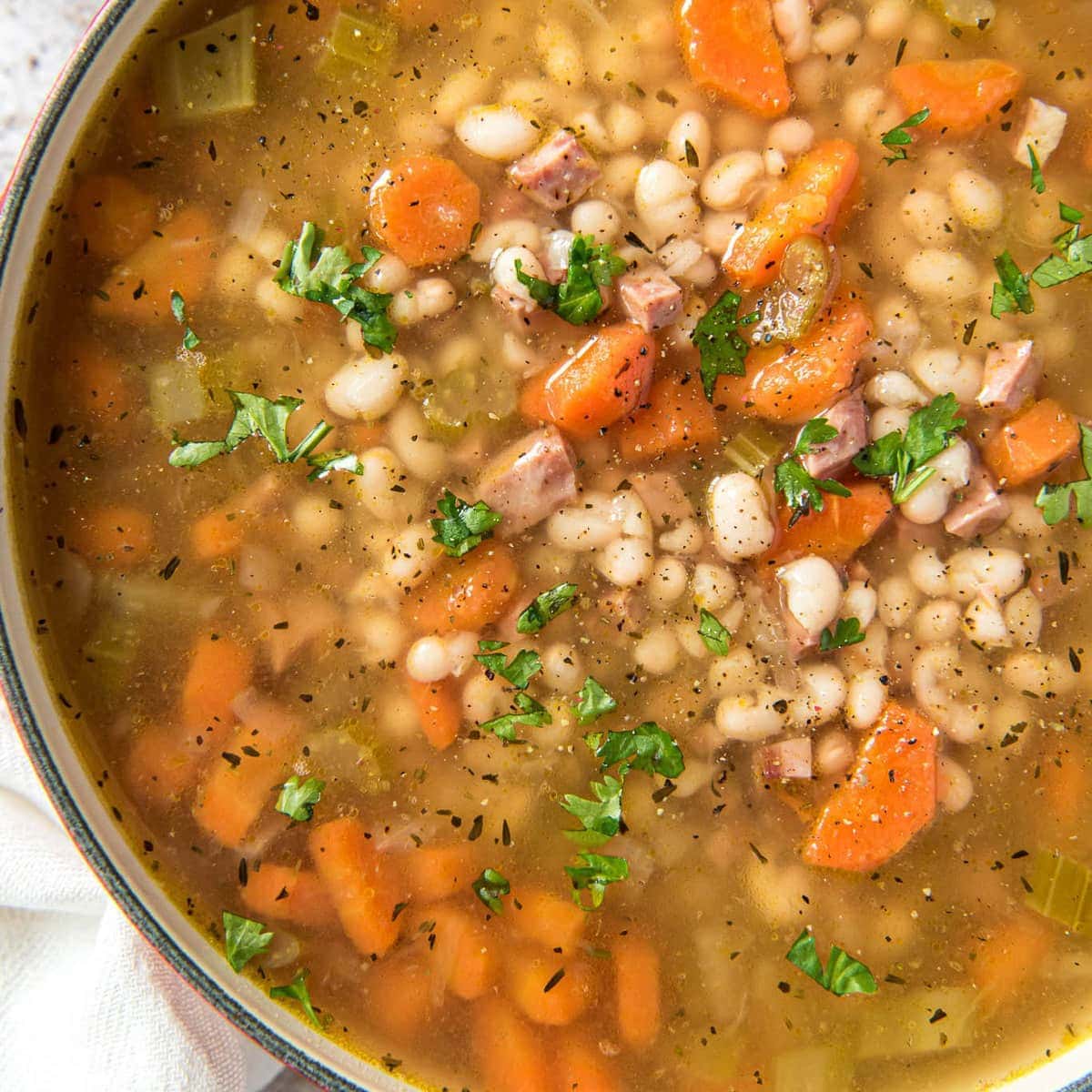Navy Bean Soup With Ham: History, Nutrition, and Delicious Serving Ideas
Navy bean soup, also known as Senate bean soup, has roots in early American naval traditions. The soup’s name stems from the U.S. Navy, which began serving it to sailors in the early 20th century. Navy beans, small white beans, were a cost-effective, nutritious staple that provided protein and sustenance during long voyages.
This soup became a staple in the Senate dining room in the early 1900s, following a directive that it be served daily. This tradition continues today, linking the dish’s cultural significance to American governance and history. Other than its governmental link, navy bean soup holds a place in American hearts as a symbol of home cooking and simplicity.
Popular Variations Across Regions
Navy bean soup’s popularity has led to regional variations across the United States. In the South, cooks often add ham hocks and cornbread, enhancing the soup’s hearty nature. In New England, ham is frequently replaced with salt pork, and the soup may include a splash of cream for richness.
Midwestern variations might incorporate root vegetables like carrots and celery, adding both texture and nutrients. In the Pacific Northwest, some versions feature smoked ham or fish, reflecting local ingredients and culinary traditions. These regional adaptations showcase the soup’s versatility and its ability to incorporate local flavors and ingredients.
Key Ingredients for Navy Bean Soup With Ham
Importance of Navy Beans
Navy beans, also known as haricot beans, are the heart of navy bean soup. Small, white, and oval-shaped, they absorb flavors well and become tender when cooked. Navy beans provide a rich source of protein, fiber, and essential nutrients, making them both nutritious and filling. Their mild taste complements other ingredients like ham without overpowering the dish.
Choosing the Right Ham
Ham adds a salty, smoky flavor to navy bean soup. Smoked ham hocks, diced ham, and ham shanks are popular choices (e.g., smoked ham hocks or diced ham). Smoked ham hocks impart a deep, savory taste, while diced ham offers a more consistent texture. Ensure the ham used is high-quality and not overly salty, which can overpower the soup’s flavor. Integrating the right ham brings balance and complexity to the soup.
Step-by-Step Cooking Guide
Preparing the Beans
Start by sorting through the navy beans, removing any debris or damaged beans. Place the beans in a colander and rinse under cold water. For optimal results, soak the beans overnight in a large bowl filled with water. If short on time, use the quick soak method: place the beans in a pot, cover with water, bring to a boil, boil for 2 minutes, then let sit for 1 hour. Drain the beans before cooking.
Cooking Techniques and Timing
Heat 2 tablespoons of olive oil in a large pot over medium heat. Add diced onions, carrots, and celery, and sauté until softened, about 5 minutes. Add minced garlic and cook for an additional minute. Incorporate diced ham or a smoked ham hock, stirring to combine flavors. Add the drained beans to the pot along with 6 cups of chicken broth or water. Bring to a boil, then reduce the heat to a simmer.
Cover the pot and let the soup simmer for 1.5 to 2 hours until the beans are tender. Stir occasionally, and adjust the seasoning with salt and pepper as needed. Remove the ham hock, if used, shred the meat, and return it to the pot. For a thicker consistency, mash some of the beans with a potato masher or blend a portion of the soup. Adjust seasoning one final time before serving.
Nutritional Benefits of Navy Bean Soup
Protein and Fiber Content
Navy bean soup with ham offers high protein and fiber levels. One cup of navy beans contains about 15 grams of protein, important for muscle repair and growth. Adding ham increases the overall protein content, making the soup more satisfying. High fiber content in navy beans, around 19 grams per cup, supports digestive health. Fiber aids in maintaining healthy blood sugar levels and promotes satiety.
Vitamins and Minerals
Navy bean soup is rich in essential vitamins and minerals. Navy beans provide a good source of calcium, iron, and magnesium. Calcium aids in bone health, iron supports oxygen transport, and magnesium helps with muscle and nerve function. Ham contributes additional nutrients like vitamin B6, which plays a role in brain development and function. Combining these ingredients ensures a nutrient-dense meal promoting overall well-being.
Serving and Garnishing Suggestions
Ideal Side Dishes
Complement navy bean soup with a variety of side dishes to enhance your meal. Consider serving the soup with crusty bread like a baguette or ciabatta. The bread’s texture pairs well with the creamy soup. For a lighter option, opt for a fresh green salad. Mixed greens, cherry tomatoes, and a light vinaigrette add a refreshing contrast. Another popular choice is cornbread. Its sweetness and grainy texture provide a delightful complement to the savory soup. For something heartier, offer baked potatoes. Their fluffy interior and crispy skin make an excellent companion to the soup.
Creative Garnishing Ideas
Elevate your navy bean soup with creative garnishes. Fresh herbs like parsley, cilantro, or dill add a burst of color and fresh flavor. Crumbled bacon provides crunchy, salty goodness. A dollop of sour cream or Greek yogurt can make the soup richer and creamier. Shredded cheese, such as cheddar or parmesan, adds an extra layer of flavor complexity. For a spicy kick, sprinkle red pepper flakes or add a dash of hot sauce. Finally, lemon zest or a squeeze of fresh lemon juice brightens the dish with a hint of citrus.
By incorporating these side dishes and garnish ideas, you can transform a simple bowl of navy bean soup into a gourmet experience. Each choice offers unique taste and visual appeal, making your meal both delicious and memorable.
Conclusion
Navy bean soup with ham is more than just a comforting meal; it’s a dish rich in history and flavor. By incorporating high-quality ham and fresh garnishes, you can elevate this classic recipe into a gourmet experience. Pair it with side dishes like crusty bread or cornbread for a complete and satisfying meal. Whether you’re honoring its naval roots or simply enjoying a hearty bowl, this soup is sure to become a favorite in your culinary repertoire.






